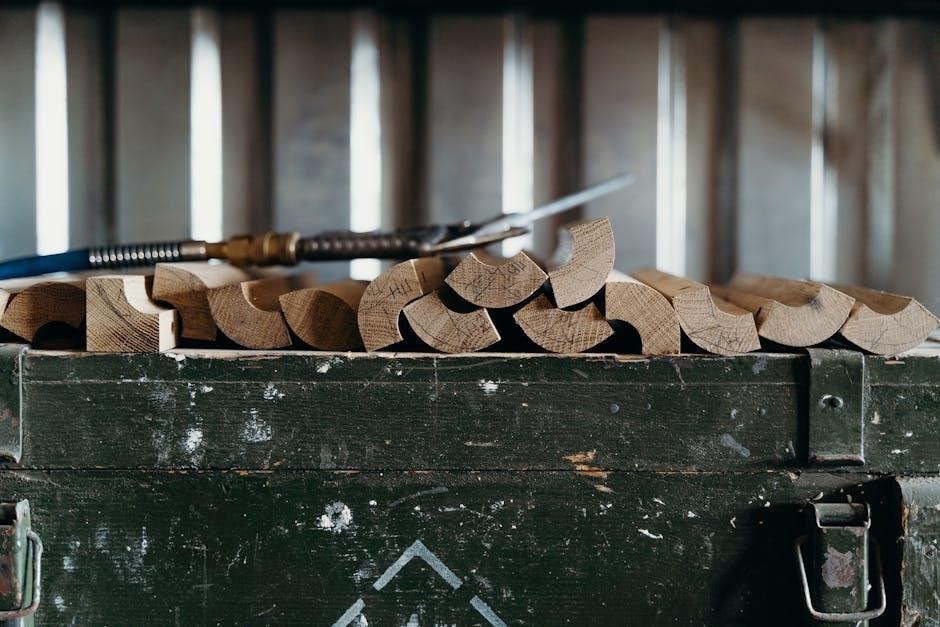A manual wood shredder is a tool designed to process branches‚ leaves‚ and wood waste into smaller pieces‚ promoting eco-friendly waste management and efficient wood processing.
1.1 What is a Manual Wood Shredder?
A manual wood shredder is a compact‚ non-motorized tool designed to process small branches‚ leaves‚ and wood waste into finer pieces. Unlike automatic shredders‚ it relies on manual effort‚ often using a handle or lever to operate. These shredders are typically simple in design‚ featuring a cutting mechanism that chops wood into manageable sizes. They are ideal for small-scale use‚ such as in gardens or workshops‚ where electric or gas-powered shredders are unnecessary. Manual shredders are eco-friendly‚ as they require no fuel or electricity‚ and they produce minimal noise. They are also cost-effective and easy to maintain‚ making them a practical choice for homeowners and hobbyists seeking to recycle wood waste efficiently.
1.2 History and Evolution of Manual Wood Shredders
The origins of manual wood shredders trace back to early human innovations in woodworking and waste management. Initially‚ basic hand tools like axes and knives were used to chop wood. Over time‚ crude mechanical devices emerged‚ utilizing levers and gears to simplify the process. By the mid-20th century‚ manual shredders evolved to include more sophisticated designs‚ such as crank-operated models‚ which improved efficiency. These early designs laid the groundwork for modern manual shredders‚ which now incorporate durable materials and ergonomic features. The evolution reflects a growing need for sustainable‚ low-cost solutions for wood waste‚ making manual shredders a vital tool for eco-conscious users today.

Benefits of Using a Manual Wood Shredder
Manual wood shredders offer eco-friendly waste management‚ reduce wood volume‚ and create mulch for gardening‚ making them ideal for small spaces and sustainable practices.
2.1 Eco-Friendly Waste Management
Manual wood shredders promote sustainable practices by converting organic waste like branches and leaves into mulch or compost‚ reducing landfill use and carbon emissions. This eco-friendly approach minimizes waste disposal while creating reusable materials for gardening. By breaking down wood waste efficiently‚ these shredders help lower greenhouse gas emissions and support environmental conservation. They encourage recycling and sustainable gardening‚ making them a responsible choice for eco-conscious individuals. The compact design and manual operation ensure minimal energy consumption‚ further enhancing their environmental benefits. This method aligns with global efforts to reduce waste and promote eco-friendly alternatives‚ making manual wood shredders a practical solution for environmentally aware users.
- Reduces landfill waste by recycling organic materials.
- Lowers carbon footprint through efficient wood processing.
- Supports sustainable gardening practices with compostable output.
2.2 Cost-Effective Solution for Wood Waste
Manual wood shredders offer a budget-friendly solution for managing wood waste‚ reducing the need for expensive waste disposal services. They are ideal for homeowners and small-scale users‚ as they require minimal investment and have low operating costs. By converting wood debris into mulch or compost‚ these shredders eliminate the expense of purchasing mulch for gardening. Their compact design and manual operation ensure energy efficiency‚ further lowering overall costs. Additionally‚ they reduce the need for frequent waste transport‚ saving time and money. Affordable models‚ like the LawnMaster FD1503 electric wood chipper‚ provide efficient performance at a reasonable price. This makes manual wood shredders a practical and economical choice for handling wood waste effectively.
- Low initial investment and operating costs.
- Reduces waste disposal and mulch purchase expenses.
- Energy-efficient design minimizes power consumption.
2.3 Space Efficiency in Small Workspaces
Manual wood shredders are designed to be compact and lightweight‚ making them perfect for small workspaces such as backyard gardens or workshops. Their space-saving design allows easy storage and portability‚ ensuring they don’t occupy valuable space. Unlike large‚ industrial shredders‚ manual models like the Power King or Champion Power Equipment are tailored for limited areas. They often come with features like foldable handles or detachable chutes‚ enhancing their versatility. This compactness ensures they can be used efficiently in tight spaces without compromising performance. Their small footprint makes them ideal for homeowners with limited storage capacity‚ allowing effective wood processing without cluttering the workspace. This space efficiency is a key advantage for users with smaller areas‚ providing practicality and convenience.

Types of Manual Wood Shredders
Manual wood shredders include chippers and mulchers‚ designed for processing wood waste into smaller pieces. They cater to various needs‚ from small-scale gardening to larger-scale shredding tasks efficiently.
3.1 Manual Chippers
A manual chipper is a device designed to shred branches‚ leaves‚ and small wood pieces into manageable sizes. These tools are ideal for gardeners and homeowners seeking to process wood waste efficiently. Unlike electric or gas-powered chippers‚ manual models rely on physical effort‚ often using a lever or handle for operation. They are typically more affordable and environmentally friendly‚ producing minimal noise and emissions. Manual chippers are perfect for small-scale applications‚ such as processing pruning debris or creating mulch for gardens. Some models‚ like the Wood-Pro 30Qi22E‚ feature manual clutches and durable blades for consistent performance. They are also lightweight and portable‚ making them easy to store and transport. For those prioritizing eco-friendly‚ cost-effective solutions‚ manual chippers offer a practical and reliable choice.
3.2 Manual Mulchers
A manual mulcher is a tool designed to break down organic materials like leaves‚ grass‚ and small wood pieces into fine mulch. These devices are eco-friendly‚ allowing users to recycle yard waste into nutrient-rich soil amendments. Unlike chippers‚ mulchers focus on creating uniform‚ smaller particles‚ which decompose quickly and improve soil structure. Manual mulchers are often compact and lightweight‚ making them ideal for small gardens or urban spaces. They operate without electricity‚ reducing carbon emissions and operational costs. Some models‚ such as the LawnMaster FD1503‚ feature electric alternatives‚ but manual versions are preferred for their simplicity and sustainability. By converting waste into mulch‚ manual mulchers support environmentally conscious gardening practices and reduce landfill contributions‚ making them a practical choice for eco-minded homeowners.

How to Choose the Right Manual Wood Shredder
Assess your needs‚ consider key features like durability and efficiency‚ and read reviews to select the best manual wood shredder for your specific requirements and budget.
4.1 Assessing Your Needs and Requirements
When selecting a manual wood shredder‚ evaluate the size and type of wood debris you typically handle. Consider the thickness of branches and the volume of material to be processed regularly. If you have a small garden or limited space‚ a compact shredder may suffice. For larger areas or heavier-duty tasks‚ a more robust model with higher capacity would be appropriate. Additionally‚ think about the desired output‚ such as fine mulch or coarser chips‚ as this will influence the choice of shredder type. Understanding your specific needs ensures you choose a tool that optimizes efficiency and performance for your particular situation.
4.2 Key Features to Look For
When selecting a manual wood shredder‚ prioritize features that enhance performance and durability. Look for a sturdy construction‚ preferably made from high-quality materials like steel‚ to ensure longevity. The cutting mechanism is crucial—durable blades or teeth that can handle various wood sizes and types are essential. Consider the maximum branch diameter the shredder can handle‚ as this determines its versatility. Ease of operation is another key factor; a smooth‚ ergonomic design reduces effort and fatigue. Safety features‚ such as secure feeding chutes or protective guards‚ are vital to prevent accidents. Additionally‚ check for portability options like wheels or handles‚ which improve mobility. Optional features like mulching capabilities or adjustable settings can further tailor the shredder to your needs‚ ensuring efficient and effective wood processing.
4.3 Importance of Reading Reviews and Ratings
Reading reviews and ratings is crucial when selecting a manual wood shredder‚ as it provides insights into real-world performance and user satisfaction. Reviews highlight the shredder’s efficiency‚ reliability‚ and durability‚ helping you avoid potential pitfalls. Pay attention to feedback on handling capacity‚ ease of use‚ and maintenance requirements. Positive reviews often emphasize features like robust construction‚ sharp blades‚ and smooth operation‚ while negative ones may flag issues like jamming or difficulty in processing harder woods. Look for consistent praise or concerns across multiple sources to gauge the shredder’s suitability for your needs. Additionally‚ ratings can indicate overall customer satisfaction‚ guiding you toward models with a proven track record of performance and value;

Safety Precautions When Using a Manual Wood Shredder
Always check blade conditions‚ wear protective gear‚ ensure proper handling‚ and avoid loose clothing. Maintain a stable setup to prevent accidents and ensure safe operation.
5.1 Essential Safety Tips for Operation
Operating a manual wood shredder requires careful attention to safety to prevent accidents. Always ensure the blades are free from damage or wear‚ as dull or damaged blades can cause unpredictable behavior. Wear protective gear‚ including gloves‚ safety goggles‚ and a dust mask‚ to shield yourself from flying debris and dust. Properly grip the handle to maintain control‚ and avoid loose clothing that might get caught in the mechanism. Never leave the shredder unattended while in use‚ and keep children and pets at a safe distance. Ensure the shredder is placed on a stable‚ even surface to prevent tipping. Follow the manufacturer’s guidelines for maximum load capacity to avoid overloading‚ which can lead to mechanical failure. Regularly inspect the shredder for any signs of wear or damage‚ and address issues promptly. By adhering to these safety tips‚ you can ensure a safe and efficient shredding process.
5.2 Importance of Protective Gear
Protective gear is crucial when operating a manual wood shredder to minimize the risk of injury. Always wear gloves to maintain a firm grip and protect your hands from splinters or cuts. Safety goggles are essential to shield your eyes from flying debris‚ while a dust mask prevents inhalation of wood particles. Steel-toe boots or sturdy footwear can protect your feet from heavy objects or accidental drops. Proper protective equipment ensures a safer working environment and reduces the likelihood of accidents. Neglecting to wear protective gear can lead to serious harm‚ making it a critical aspect of responsible shredder operation.
5.3 Handling Emergency Situations
In case of an emergency while using a manual wood shredder‚ it is crucial to act swiftly and responsibly. First‚ immediately stop the machine by disconnecting the power source or releasing the manual clutch. Never attempt to remove debris while the shredder is in motion‚ as this can exacerbate the situation. Use a long-handled tool‚ such as a stick or trowel‚ to carefully clear any blockages. If a body part is caught‚ turn off the device and seek immediate assistance; Ensure the area is clear of bystanders and keep a first aid kit nearby. Regularly inspect the machine to prevent malfunctions and always follow the manufacturer’s emergency procedures. Preparedness is key to minimizing risks and ensuring safe operation.

Maintenance and Troubleshooting
Regularly inspect and sharpen blades‚ lubricate gears‚ and clear blockages to ensure smooth operation. Schedule professional servicing if issues persist‚ and follow the manufacturer’s guidelines for optimal performance and longevity.
6.1 Regular Maintenance Tips
Regular maintenance is crucial for extending the life of your manual wood shredder. Start by inspecting the blades and sharpening them as needed to ensure efficient cutting. Lubricate moving parts to reduce friction and prevent rust. Clear debris from the shredder chute and discharge areas to maintain proper airflow. Check belts and gears for wear and tear‚ replacing them when necessary. Additionally‚ review the owner’s manual for specific maintenance schedules tailored to your model. Consistently following these tips will help prevent breakdowns and ensure optimal performance. Remember‚ a well-maintained shredder operates safely and efficiently‚ making your wood processing tasks easier and more productive.
6.2 Common Issues and Solutions
Common issues with manual wood shredders often stem from improper use or neglect. Dull blades can hinder performance‚ so regular sharpening is essential. Jamming may occur if the shredder is overloaded; clearing debris and reducing the load usually resolves this. Vibrations during operation could indicate misaligned or loose blades‚ which need tightening or realignment. Additionally‚ using the shredder for materials it’s not designed for‚ like metal or plastic‚ can damage the mechanism. Always refer to the manual for compatible materials. For persistent issues‚ check for worn parts and replace them as needed. Addressing these problems promptly ensures smooth operation and extends the shredder’s lifespan. Proper care and troubleshooting can prevent major repairs and keep your manual wood shredder functioning effectively.
6.3 DIY Repair and Parts Replacement
DIY repair and parts replacement for manual wood shredders can be straightforward with the right tools and knowledge. Blades and cutting edges often need sharpening or replacing due to wear. Refer to the owner’s manual for specific instructions‚ as different models may vary. Common parts like flywheels or gears can be sourced from manufacturers or online retailers. Before starting any repair‚ ensure the shredder is disconnected from power and wear protective gear. For complex issues‚ such as motor or transmission problems‚ consulting a professional may be necessary. Regular maintenance‚ like lubricating moving parts and checking for loose components‚ can prevent major repairs. Always follow safety guidelines to avoid accidents during the repair process. Properly replacing worn parts ensures optimal performance and extends the shredder’s lifespan.

Environmental Impact of Manual Wood Shredders
Manual wood shredders promote sustainable waste management by recycling organic materials‚ reducing landfill waste‚ and lowering greenhouse gas emissions through efficient wood processing and reuse.
7.1 Recycling and Reusing Wood Waste
Manual wood shredders play a crucial role in recycling and reusing wood waste‚ transforming it into valuable materials like mulch‚ compost‚ or fuel. By processing branches‚ leaves‚ and small wood pieces‚ these shredders help reduce landfill waste and promote sustainable practices. The shredded wood can be repurposed for garden beds‚ pathways‚ or as natural fertilizer‚ enriching soil health. This approach minimizes the need for industrial wood products‚ lowering environmental impact. Additionally‚ recycling wood waste reduces the demand on forests‚ contributing to conservation efforts. Manual shredders are eco-friendly tools that empower individuals and communities to manage wood waste responsibly‚ fostering a circular economy and reducing waste disposal challenges.
7.2 Reducing Carbon Footprint
Manual wood shredders significantly reduce carbon footprint by minimizing waste and promoting sustainable practices; Unlike electric or gas-powered shredders‚ manual models operate without emissions‚ eliminating CO2 output during use. By processing wood waste locally‚ they reduce the need for transportation‚ which is a major contributor to greenhouse gas emissions. Recycling wood into mulch or compost decreases landfill dependency‚ where organic waste decomposes and releases methane. Additionally‚ manual shredders encourage the reuse of wood materials‚ reducing the demand for new products and the energy required to produce them. This eco-friendly approach not only lowers carbon emissions but also supports a more sustainable and environmentally conscious lifestyle‚ making manual wood shredders a greener choice for managing wood waste effectively.
7.3 Lowering Greenhouse Gas Emissions
Manual wood shredders play a significant role in lowering greenhouse gas emissions by reducing the need for industrial-scale waste processing. Unlike electric or gas-powered shredders‚ manual shredders operate without consuming fossil fuels‚ thereby eliminating direct emissions of carbon dioxide and other pollutants. By processing wood waste locally‚ they minimize the need for transportation‚ which is a major contributor to greenhouse gas emissions. Additionally‚ manual shredders help reduce landfill waste‚ where organic materials decompose and release methane‚ a potent greenhouse gas. By converting wood waste into reusable materials like mulch or compost‚ these shredders support sustainable practices that reduce the overall carbon footprint associated with waste management. This eco-friendly approach aligns with global efforts to mitigate climate change by reducing greenhouse gas emissions effectively.
Manual wood shredders offer a practical‚ eco-friendly‚ and cost-effective solution for managing wood waste. By converting branches and leaves into mulch or compost‚ these tools promote sustainability and reduce landfill dependence. Their compact design makes them ideal for small spaces‚ while their manual operation ensures minimal environmental impact. With proper maintenance and safe usage‚ manual wood shredders can serve as a reliable and efficient addition to any homeowner’s or gardener’s toolkit. Embracing this traditional yet effective method supports a greener lifestyle‚ reducing waste and fostering a healthier environment for future generations.